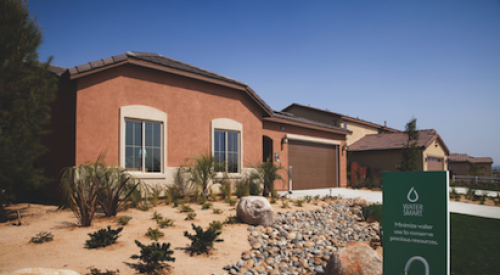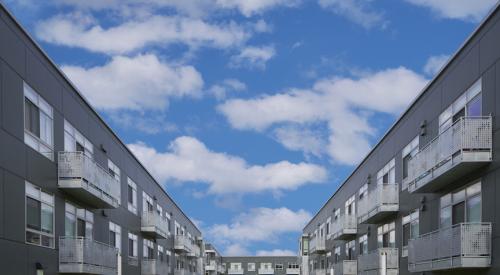| Left to right, Bruce Polishook, Frank Edwards, Vince Drose, and Fernando Domenech have made affordable housing part of their respective companies’ market niches. The demand is always there, and when partnering with federally funded agencies, the money will often be there even during recessions.
|
In good economic times and in bad, affordable housing remains in constant demand. However, when neighborhoods are on the rebound, the increased market value of urban land often clashes with the increased demand for affordable housing, forcing middle-class and low-income families to rent or move - not a real good way to keep the neighborhood on the upswing.
The South Boston/Lower Roxbury area has been enjoying an extended revitalization, and development teams like the one behind Davenport Commons have been a big part of that. If this community model serves as any indication, this team is mapping out a winning strategy.
Davenport Commons promises to be another affordable oasis for potential home buyers in a once-vast desert of homes priced beyond their reach. The city-owned parcel stood vacant for nearly 20 years until a group of lenders, developers, builders and local institutions came up with a plan to suit the city planners, local residents and their own bottom line.
"The lot was designated as an urban renewal parcel, and the community has always been very vocal and active in ensuring the lot would be used properly," says Vince Droser, project manager for Davenport Commons. "The people who work, play, own homes and rent in the neighborhood wanted enough affordable housing to make sure they and their friends could remain there." Droser is also vice president of Boston-based Trinity Financial, Inc., the development manager and one of three entities responsible for the development of Davenport Commons.
| Davenport Commons features loads of scale elements on the exterior architecture. Differing stoops and bay windows along the street, a mansard level on the top floor, differently articulated corners and bold color schemes help this development blend with and enhance the neighborhood.
|
Enter funding partners, agencies, the development team, an architectural firm and two builders experienced in providing affordable urban housing. Droser says that after a bit of sometimes contentious but always productive back-and-forth among all concerned parties, a model was finally agreed upon that satisfied everyone - one that includes 85 townhome and duplex units starting at $89,000.
There are more than a dozen funding partners in Davenport Commons, including the city of Boston, the Massachusetts Housing Finance Agency and Citizens Bank of Massachusetts. While the partners provided the monies allowing these units to be sold well below market average - while still providing necessary profits for developers, builders and architects - it was the inclusion of Northeastern University that was the unique key to this project.
The school, located very near this parcel, was running out of space and in need of more student housing. Being involved with Davenport Commons allowed them to gain 125 apartment-style suites for their students, while their resources and access to federal funds went a long way in enabling 75 affordable for-sale homes to be built.
| CWC Builders helped bring an added level of affordability to Davenport Commons with the extensive use of panelized materials, saving on labor, time and materials.
|
Droser says that while many of the particulars in this land deal hinge upon the specific needs of the various partners, this particular parcel and this neighborhood specifically, the overall concept can be applied to almost any city.
"While our partnership with Northeastern is unique - I don’t think there is any other model on this scale that leverages the resources of a university to provide affordable community housing - the practice of leveraging the resources of community institutions in general is tried-and-true," says Droser.
What this partnership has produced are homes targeted not only at low-income buyers, but at working and middle-class families as well. This reflects the needs and desires of the community, where the median income has slowly risen to around $50,000 and median home prices have doubled since 1993 to $300,000.
"The community was very keen on providing homes for people who are living, working and playing in the neighborhood now but have been forced to rent," says Fernando Domenech, president of Domenech, Hicks & Krockmalnic, the Boston-based architectural firm that designed Davenport Commons. This is key in revitalizing urban areas such Boston’s south side: providing housing for a wider range of incomes as opposed to only low-income "projects" or high-end condos which push out certain demographics and ignore the inherent diversity of such neighborhoods.
The homes will be available to qualifying buyers this November. All 15 units at Shawmut Estates (a batch of houses approximately 1/2 mile from the main site, but still part of the same development deal) are available to households at or below 80% of median income. Thirty-seven of the 60 units at the main site are available at this income range, while 11 units are available to those with incomes between 81% and 120% of the area median. The remaining 12 units are available to buyers whose incomes are verified to be between 121% and 175% of median.
One-bedroom homes start at $89,000, while two-bedroom units start at $95,500 and three bedrooms start at $106,250. Even with the help of the funding partners, it took careful construction to build homes selling so far below the average $230,000 it cost to build them.
Bruce Polishook, president of CWC Builders, Inc. of Newton, Mass. (the general contractor responsible for the for-sale housing units), has perfected a panelization process that saves him time, resources, labor and ultimately, money.
"Our prefabrication method is faster, creates less waste, is more time and labor-efficient and allows us better quality control," says Polishook. "Panelization is often compared to modular construction, but we’ve been able to bid jobs significantly lower than modular builders which has won us a few contracts."
By working with the architectural team to design enough repetitive elements such as roofs, wall panels, stairs, windows and partitions, these elements can be constructed off-site while the foundation is being poured. This maximizes efficiency of both production and installation, cutting costs and providing savings to buyers.
"We also utilize engineered lumber and high-efficiency mechanicals," says Polishook. "And on non load-bearing interior walls we use metal studs that provide for faster construction of straighter walls - that reduces callbacks."
Teamwork during the design phase is vital to making panelization work. CWC has worked with Domenech, Hicks & Krockmalnic on several projects over the last 10 years, and by now they are used to each other’s needs. "We’re used to designing for panelization, and as long as there are enough repetitive elements to make the process sensible, you can design virtually any type of building," says Domenech.
Which brings us back to the partnership aspect of this project. More than the grants and private funding, beyond density, above design and construction efficiency, it is the way all entities worked together to provide something for each other. This includes the community-at-large, which challenged and helped the various entities come up with a project everyone could get excited about.
"All of the partners involved in this project are proud of what we’ve done here and in the past," says Domenech.
"We’ve helped fill in some gaps, provided good families with homes they can afford and helped the entire neighborhood become stronger."
Sidebar:












